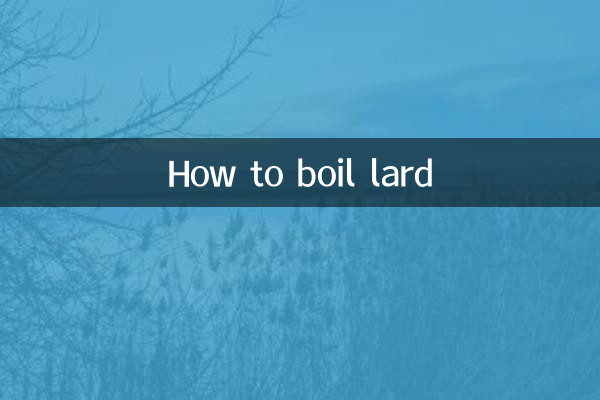How to boil lard
In the past 10 days, the discussion on "boiling lard" has increased significantly across the Internet, especially in topics related to gourmet preparation, healthy eating and traditional cooking techniques. The following is a compilation of hot topics and hot content in the past 10 days:
| hot topics | Discussion popularity | Main point |
|---|---|---|
| The health value of lard | high | Lard is rich in saturated fatty acids, and moderate consumption is good for cardiovascular health |
| Traditional method of boiling lard | Middle to high | The cooking techniques of the older generation are being refocused, with emphasis on low heat and slow cooking |
| Various ways to eat lard residue | in | Lard residue can be used as snacks, noodles or stir-fry ingredients, and is very popular |
| Modern simplified oil boiling method | in | Quick cooking methods using modern kitchenware such as rice cookers and air fryers |
1. Why boil lard?

Lard, as an important ingredient in traditional Chinese cooking, has recently received renewed attention for the following reasons:
1. Changes in health concepts: Research has found that moderate amounts of animal fat are beneficial to health
2. Unique flavor: lard can add unique flavor to dishes
3. Economical: boiling lard is more cost-effective than buying finished product
4. Zero waste: using pork trimmings is in line with modern environmental protection concepts
2. Traditional method of boiling lard
| steps | Operational points | Things to note |
|---|---|---|
| 1. Selection of materials | Choose pork suet or fatty pork | Fresh and no smell is better |
| 2. Cut into pieces | Cut into 3-5cm cubes | Uniform size and consistent heating |
| 3. Blanch | Boil cold water for 1 minute | Remove impurities and fishy odor |
| 4. Boil | Simmer over low heat for 2-3 hours | Avoid burning due to fire |
| 5. Filter | Filter the oil residue through a fine sieve | Make sure the oil is pure |
| 6. Storage | Put into clean container and seal | Store refrigerated away from light |
3. Modern simple method of boiling oil
In view of the fast-paced life of modern people, the following are two simplified cooking methods:
1.Rice cooker cooking method: Put the cut lard cubes into the rice cooker, add a small amount of water, select the "cooking" mode, wait until it automatically trips and then filter.
2.Oven cooking method: Lay the lard cubes flat on a baking sheet, bake at 120°C for 2 hours, flip several times, and finally filter.
4. Frequently Asked Questions
| question | Answer |
|---|---|
| Why is the boiled lard not white? | It may be that the heat is too high or the ingredients are not fresh. |
| What should I do if lard smells fishy? | Add ginger slices or cooking wine when blanching |
| How long can lard be kept? | Can be stored for 6 months in the refrigerator and 1 year in the freezer |
| Can you still eat the oil residue? | Yes, but it is recommended to eat in moderation |
5. Various uses of lard
1. Cooking: stir-fried vegetables, fried eggs, making snacks
2. Seasoning: add flavor to rice and noodles
3. Beauty: traditional skin care methods
4. Others: lubrication, anti-rust and other magical uses in daily life
Through the above detailed steps and methods, I believe you have mastered the skills of cooking lard. Whether you follow traditional methods or adopt modern simplified techniques, the key is to control the heat and ensure the freshness of the ingredients. Boiled lard not only makes home-cooked dishes more delicious, but also allows you to experience the fun of traditional cooking.
There has been a lot of discussion on the Internet recently about the health value of lard, but in any case, eating it in moderation and having a balanced diet is the key to health. I hope this article can help you successfully cook high-quality lard that is golden, translucent, and rich in flavor.

check the details

check the details